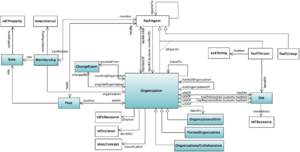Organization
Pattern
This class has been associated with the following pattern:
Subclass Of
Description
An English description of the definition (what distinguishes this sense of the term?).
An Organization represents a collection of people organized together into a community or other social, commercial or political structure. The group has some common purpose or reason for existence which goes beyond the set of people belonging to it. An organization may itself be able to act as an agent. Properties included are:
- hasName: a string name of the Organization
- org:hasMember: identifies the agents that are members of the Organization.
- org:hasSubOrganization: identifies the sub-Organizations within the Organization.
- org:hasUnit: indicates an OrganizationUnit which is part of the Organization.
- org:hasPost: identifies the Posts that exist in the Organization.
- hasAsset: identifies the assets possessed by the Organization
Organizations provide another source of influence on the behaviour in the urban system. An organization is defined broadly as a formal or semi-formal groups for which structure and behaviour are defined. Organizations such as schools and businesses are particularly important for cities as they determine regular travel patterns and other activities for much of the population. The Organization Ontology is drawn from the TOVE model of an Organization, originally presented in. In particular, definitions of the concepts of Organization, Organization Agent, Role, and Goal are adopted here. In addition, the Organization Ontology introduces the concepts of Students and Employees who are members of certain types of Organizations. Using the Spatial Location ontology, the Organization ontology captures the location of a person's work or school. The Change Ontology is used to support the representation of variable attributes of an organization, such as its location and members.
Organization is a company or other sort of formal or informal group of individuals in the urban system with some identified structure and behaviour.
- An Organization may own Property, including different types of Buildings.
- An Organization may have an address.
- An Organization has at least 2 members.
- An Organization has some Goal(s); this represents some state or complex states, and allows for the representation of various groups' responsibilities.
- An Organization may be divided into sub-organizations which are themselves Organizations.
Class Diagram Description
Figure 1 depicts the main classes and properties in the W3C Organization Ontology.
Required by Use Case(s)
(why is this specialized definition needed?)
CDM References
What other classes or properties reference this term?
- OrganizationalUnit (← links)
- Post (← links)
- Firm (← links)
- OrganizationAgent (← links)
- Employee (← links)
- Stakeholder (← links)
- Pattern:Organization Pattern (← links)
Interface Specification References
This class has been associated with the following interface specification items:
Sources
Sources considered when developing the class:
Status
Pending Approval
Has Subclass(es)
Annotations
| Annotation | Value |
|---|
Manchester Syntax Specification
| Property | Restriction | Value |
|---|---|---|
| HasName | exactly 1 | xsd:string |
| Org:hasMember | only | ISO5087-1:Agent |
| Org:hasSubOrganization | only | Organization |
| Org:subOrganizationOf | only | Organization |
| Org:hasPost | only | Post |
| HasAsset | only | Asset |
| Org:hasUnit | only | OrganizationUnit |
| HasAddress | only | ISO5087-2:Address |
| HasPhoneNumber | only | PhoneNumber |
| HasOperatingHours | only | OperatingHours |
| HasGoal | only | Goal |
| AssociatedLocation | only | Feature |
Supplementary Figures
| Figure | Caption |
|---|---|
| Figure 1: The Organization Ontology main classes and properties from |
